Discrete-Time Design of Dual Internal Model-Based Repetitive Control Systems
Abstract
:1. Introduction
- A novel dual internal model-based RC is constructed by using the denominator parts of the general and higher-order internal models.
- Stability conditions of the plug-in DIMRC system are presented. The stability conditions are then used to determine the stabilizing controller.
- The structure and realization of DIMRC for the non-causal stabilizing controller are developed.
2. Problem Statement
3. Discrete-Time RC
3.1. A General Modified RC
3.2. A Higher-Order Modified RC
4. Proposed Dual Internal Model-Based RC (DIMRC)
4.1. DIMRC Structure
4.2. Stability of the Plug-In RC System
- Obtain the open-loop plant model (2).
- Pick the conventional controller , ensuring a stable (25).
- Choose the order of HOMRC m, and determine the weights based on (12) and (13).
- Construct the by using (21).
- Determine the stabilizing controller satisfying (28).
- Synthesize the complete controller according to (17).
5. Simulation Results
5.1. Case 1: Minimum Phase Stabilized System
5.2. Case 2: Non-Minimum Phase Stabilized System
6. Conclusions
Author Contributions
Funding
Institutional Review Board Statement
Informed Consent Statement
Data Availability Statement
Acknowledgments
Conflicts of Interest
Abbreviations
| DIMRC | Dual internal model-based repetitive controller. |
| GMRC | General modified repetitive controller. |
| HOMRC | Higher-order modified repetitive controller. |
| LTI | Linear time invariant. |
| MPRC | Multi-Periods Repetitive Control. |
| RC | Repetitive controller. |
| ZPETC | Zero-phase tracking error controller. |
References
- Francis, B.A.; Wonham, W.M. The internal model principle for linear multivariable regulators. Appl. Math. Optim. 1975, 2, 170–194. [Google Scholar] [CrossRef]
- Hillerstrom, G.; Walgama, K. Repetitive control theory and applications—A survey. In Proceedings of the 13th IFAC World Congress, San Francisco, CA, USA, 30 June–5 July 1996; pp. 1–6. [Google Scholar]
- Kurniawan, E.; Cao, Z.; Mahendra, O.; Wardoyo, R. A survey on robust Repetitive Control and applications. In Proceedings of the 2014 IEEE International Conference on Control System, Computing and Engineering, Penang, Malaysia, 28–30 November 2014; pp. 524–529. [Google Scholar]
- Liu, Y.; Wu, P.; Ferrari, R.M.G.; Van Wingerden, J.W. Fast adaptive fault accommodation in floating offshore wind turbines via model-based fault diagnosis and subspace predictive repetitive control. IFAC-PapersOnLine 2020, 53, 12650–12655. [Google Scholar] [CrossRef]
- Meng, F.; Zhang, X.; Li, Z.; Wen, X.; You, L. Speed Fluctuation Suppression for the Inverter Compressor Based on the Adaptive Revised Repetitive Controller. Energies 2020, 13, 6342. [Google Scholar] [CrossRef]
- Cui, P.; Zhang, G. Modified Repetitive Control for Odd-Harmonic Current Suppression in Magnetically Suspended Rotor Systems. IEEE Trans. Ind. Electron. 2019, 66, 8008–8018. [Google Scholar] [CrossRef]
- Page, A.P.; Freeman, C.T. Point-to-point repetitive control of functional electrical stimulation for drop-foot. Control Eng. Pract. 2020, 96, 1–10. [Google Scholar] [CrossRef]
- Li, L.; Aphale, S.S.; Zhu, L. Enhanced odd-harmonic repetitive control of nanopositioning stages using spectrum-selection filtering scheme for high-speed raster scanning. IEEE Trans. Automat. Sci. Eng. 2021, 18, 1087–1096. [Google Scholar] [CrossRef]
- Cai, K.; Deng, Z.; Peng, C.; Li, K. Suppression of Harmonic Vibration in Magnetically Suspended Centrifugal Compressor Using Zero-Phase Odd-Harmonic Repetitive Controller. IEEE Trans. Ind. Electron. 2020, 67, 7789–7797. [Google Scholar] [CrossRef]
- Nakano, M.; Hara, S. Microprocessor-based repetitive control. Microprocess. Based Control Syst. 1986, 4, 279–296. [Google Scholar]
- Chew, K.-K.; Tomizuka, M. Steady-state and stochastic performance of a modified discrete-time prototype repetitive controller. Trans. ASME J. Dyn. Syst. Meas. Contr. 1990, 112, 35–41. [Google Scholar] [CrossRef]
- Hillerstrom, G.; Sternby, J. Repetitive control using low order models. In Proceedings of the American Control Conference, Baltimore, MD, USA, 29 June–1 July 1994; Volume 2, pp. 1873–1878. [Google Scholar]
- Grino, R.; Costa-Castello, R. Digital repetitive plug-in controller for odd-harmonic periodic references and disturbances. Automatica 2005, 41, 153–157. [Google Scholar] [CrossRef]
- Kurniawan, E.; Afandi, M.I.; Suryadi, S. Repetitive control system for tracking and rejection of multiple periodic signals. In Proceedings of the International Conference on Robotics, Automation and Sciences (ICORAS), Melaka, Malaysia, 27–29 November 2017; pp. 1–5. [Google Scholar]
- Steinbuch, M.; Weiland, S.; Singh, T. Design of Noise and Period-time Robust High-order Repetitive Control, with Application to Optical Storage. Automatica 2007, 43, 2086–2095. [Google Scholar] [CrossRef]
- Huang, W.-W.; Hu, C.; Zhu, L.-M. Robust Repetitive Control of Nanopositioning Stages Using the Spectrum-Selection Filter with Narrow Passbands. IEEE/ASME Trans. Mechatron. 2022, 27, 4211–4216. [Google Scholar] [CrossRef]
- Tian, M.; Wang, B.; Yu, Y.; Dong, Q.; Xu, D. Discrete-Time Repetitive Control-Based ADRC for Current Loop Disturbances Suppression of PMSM Drives. IEEE Trans. Ind. Inform. 2022, 18, 3138–3149. [Google Scholar] [CrossRef]
- Jamil, M.; Waris, A.; Gilani, S.O.; Khawaja, B.A.; Khan, M.N.; Raza, A. Design of Robust Higher-Order Repetitive Controller Using Phase Lead Compensator. IEEE Access 2020, 8, 30603–30614. [Google Scholar] [CrossRef]
- Lu, W.; Wang, W.; Zhou, K.; Fan, Q. General High-Order Selective Harmonic Repetitive Control for PWM Converters. IEEE J. Emerg. Sel. Top. Power Electron. 2022, 10, 1178–1191. [Google Scholar] [CrossRef]
- Duan, C.; Gu, G.; Du, C.; Chong, T.C. Robust Compensation of Periodic Disturbances by Multirate Control. IEEE Trans. Magn. 2008, 44, 413–418. [Google Scholar] [CrossRef]
- Yang, R.; Wang, M.; Li, L.; Wang, G.; Zhong, C. Robust Predictive Current Control of PMLSM With Extended State Modeling Based Kalman Filter: For Time-Varying Disturbance Rejection. IEEE Trans. Power Electron. 2020, 35, 2208–2221. [Google Scholar] [CrossRef]
- Landau, I.D.; Constantinescu, A.; Rey, D. Adaptive narrow band disturbance rejection applied to an active suspension—An internal model principle approach. Automatica 2005, 41, 563–574. [Google Scholar] [CrossRef]
- Zhao, R.; Xie, W.; Yu, G.; Wang, G.; Wong, P.K.; Silvestre, C. Adaptive ride height controller design for vehicle active suspension systems with uncertain sprung mass and time-varying disturbance. Int. J. Robust Nonlinear Control 2022, 32, 5950–5966. [Google Scholar] [CrossRef]
- Manayathara, T.J.; Tsao, T.-C.; Bentsman, J. Rejection of unknown periodic load disturbances in continuous steel casting process using learning repetitive control approach. IEEE Trans. Control Syst. Technol. 1996, 4, 259–265. [Google Scholar] [CrossRef]
- Ma, Z.; Fang, Y.; Zheng, H.; Liu, L. Active Disturbance Rejection Control With Self-Adjusting Parameters for Vibration Displacement System of Continuous Casting Mold. IEEE Access 2019, 7, 52498–52507. [Google Scholar] [CrossRef]
- Tomizuka, M. Zero phase error tracking algorithm for digital control. Trans. ASME J. Dyn. Syst. Meas. Contr. 1987, 109, 65–68. [Google Scholar] [CrossRef]
- Kurniawan, E.; Adinanta, H.; Harno, H.G.; Prakosa, J.A.; Suryadi, S.; Purwowibowo, P. On the synthesis of a stable and causal compensator for discrete-time high-order repetitive control systems. Int. J. Dynam. Control 2021, 9, 727–736. [Google Scholar] [CrossRef]
- Kurniawan, E.; Cao, Z.; Man, Z. Design of Robust Repetitive Control with Time-Varying Sampling Periods. IEEE Trans. Ind. Electron. 2014, 61, 2834–2841. [Google Scholar] [CrossRef]
- Xu, K.; Longman, R.W. Use of Taylor Expansions of The Inverse Model to Design FIR Repetitive Controllers. In Spaceflight Mechanics; Advances in the Astronautical Sciences Series; American Astronautical Society: Springfield, VA, USA, 2009; Volume 134, pp. 1073–1088. [Google Scholar]
- Zhang, B.; Wang, D.; Zhou, K.; Wang, Y. Linear Phase Lead Compensation Repetitive Control of a CVCF PWM Inverter. IEEE Trans. Ind. Electron. 2008, 55, 1595–1602. [Google Scholar] [CrossRef]
- Prasitmeeboon, P.; Longman, R.W. Repetitive Control Compensator Design for Frequency Response near Singularities. J. Astronaut. Sci. 2021, 68, 916–945. [Google Scholar] [CrossRef]
- Kurniawan, E. Robust Repetitive Control and Applications. Ph.D. Thesis, Swinburne University of Technology, Hawthorn, Australia, 2013. [Google Scholar]
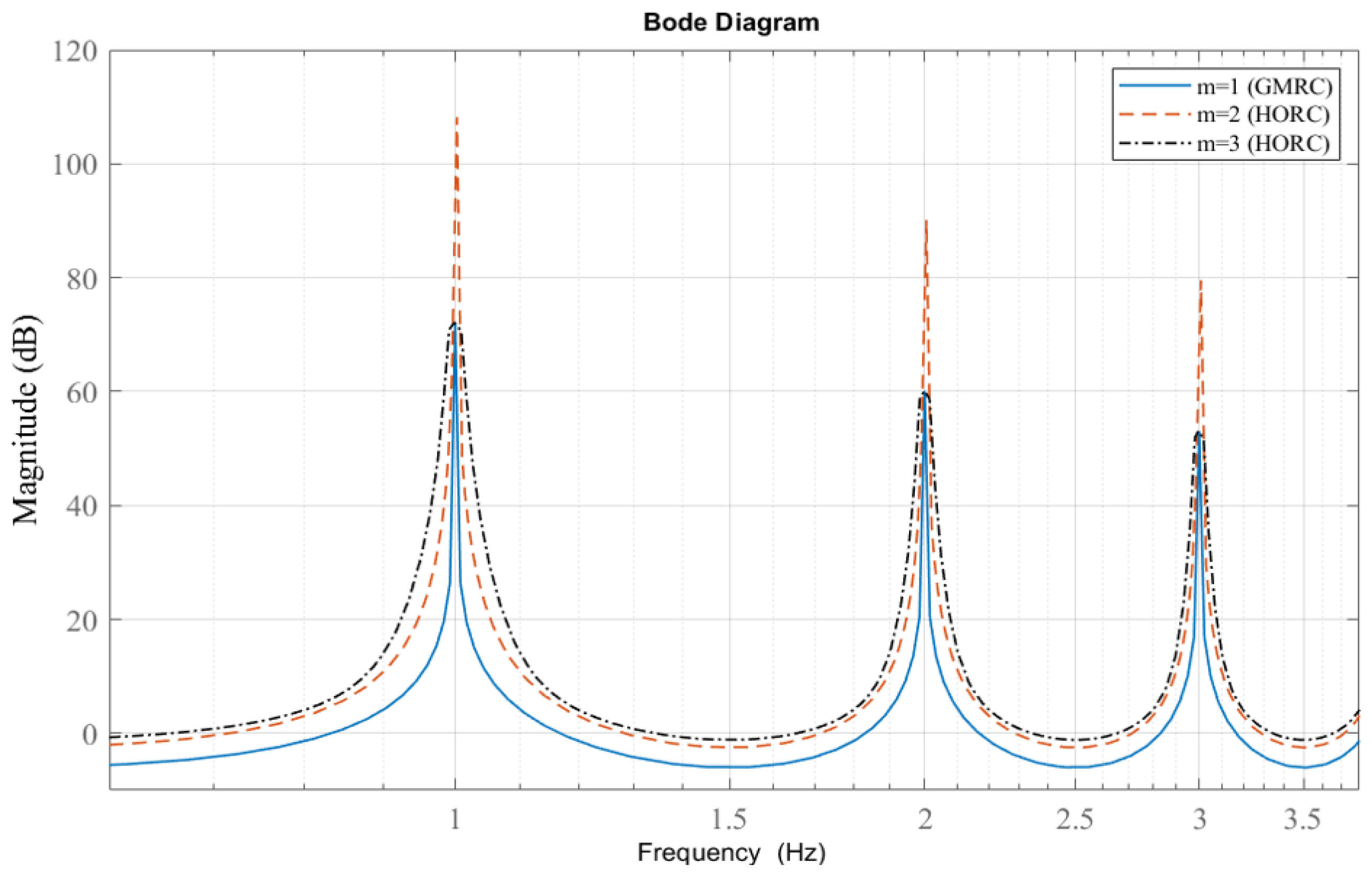


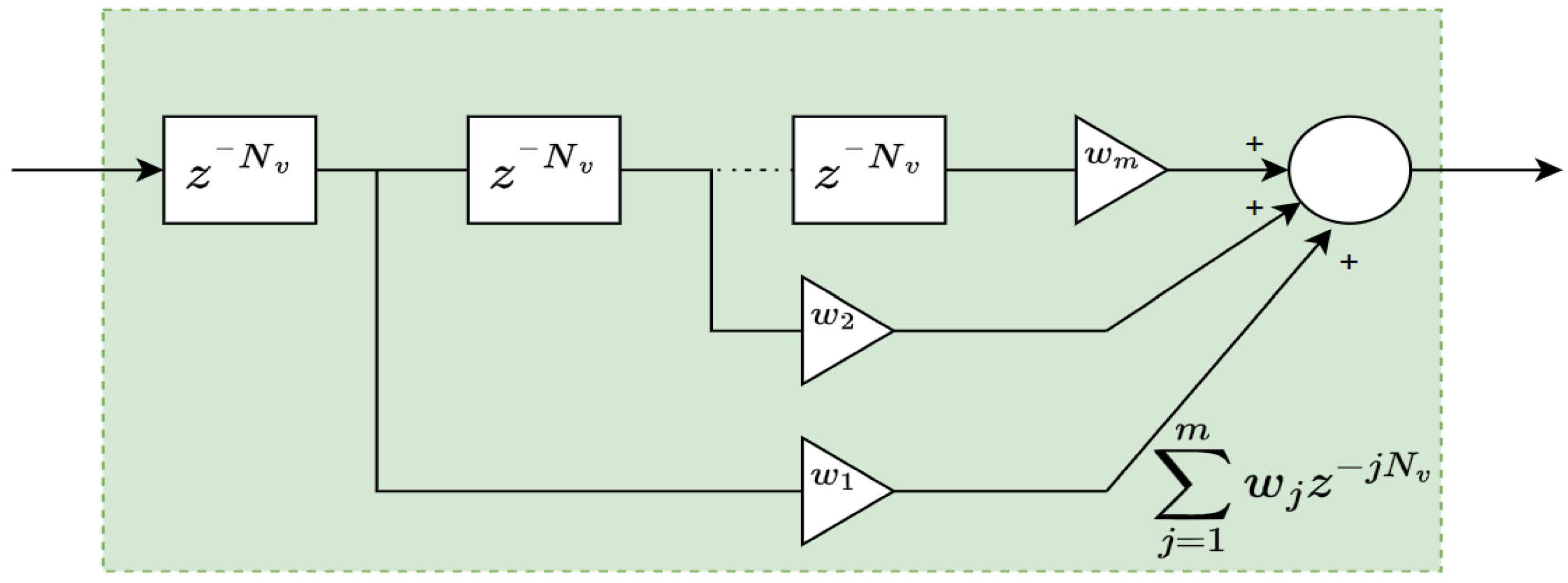


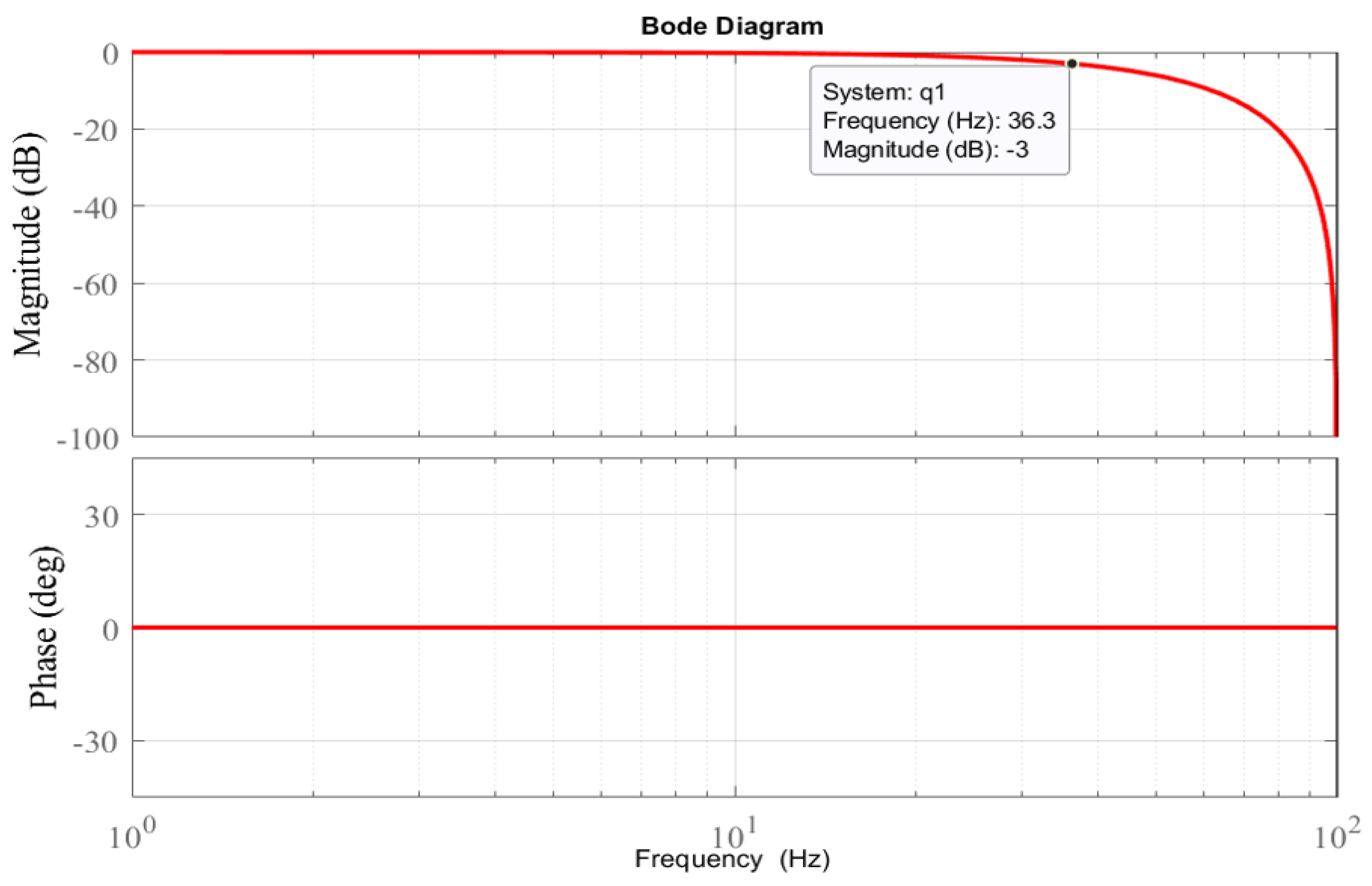
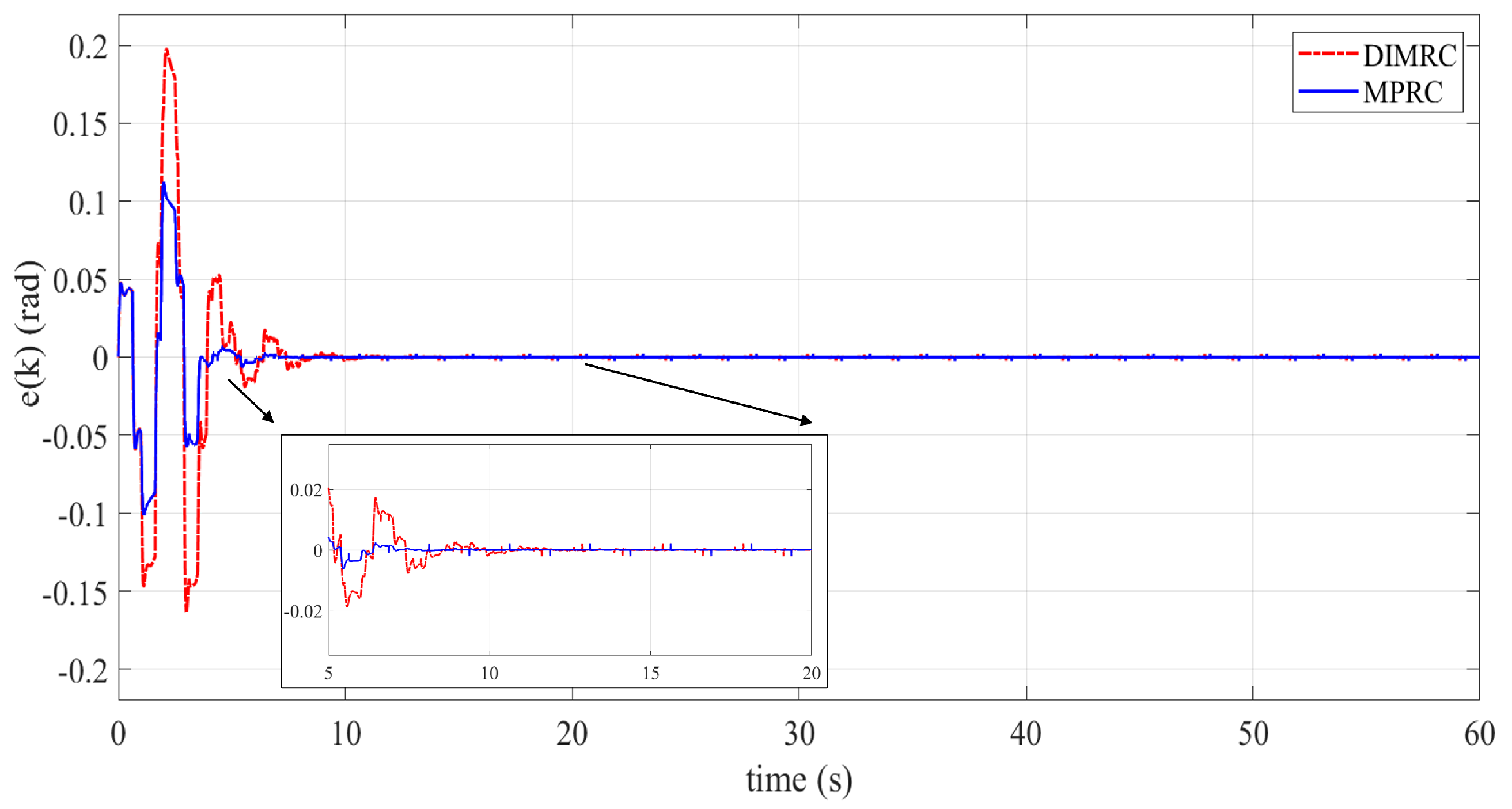
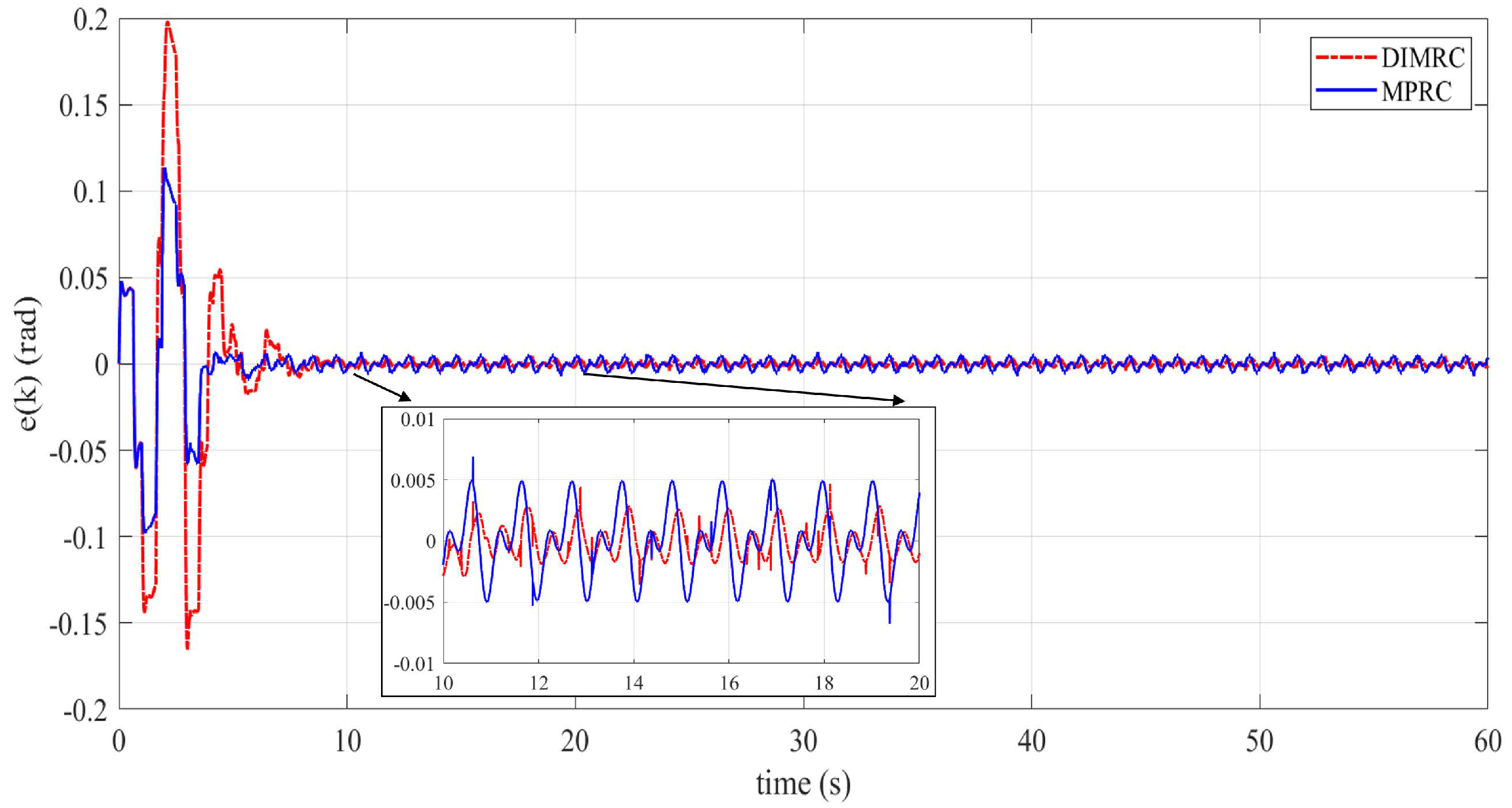
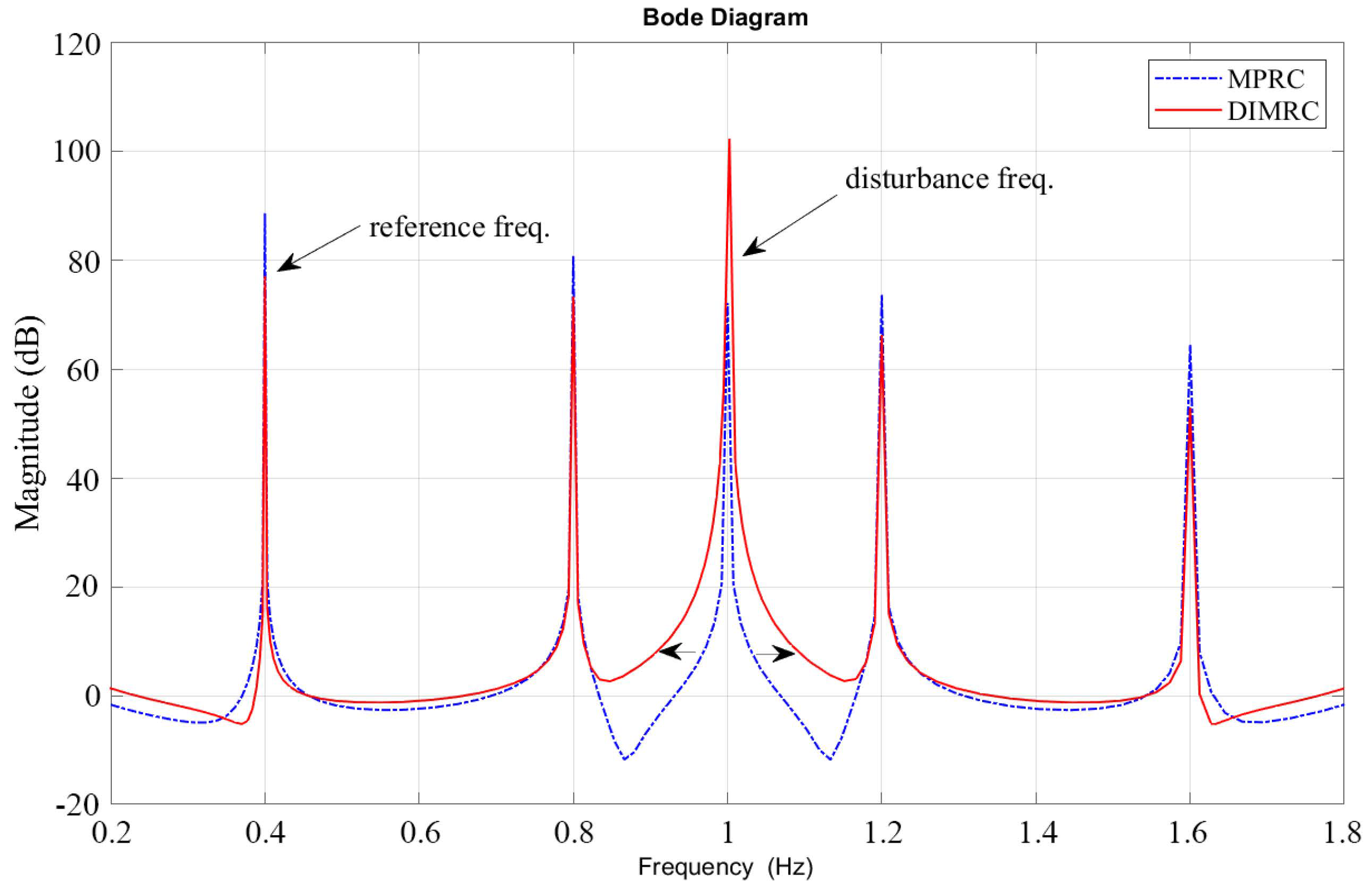
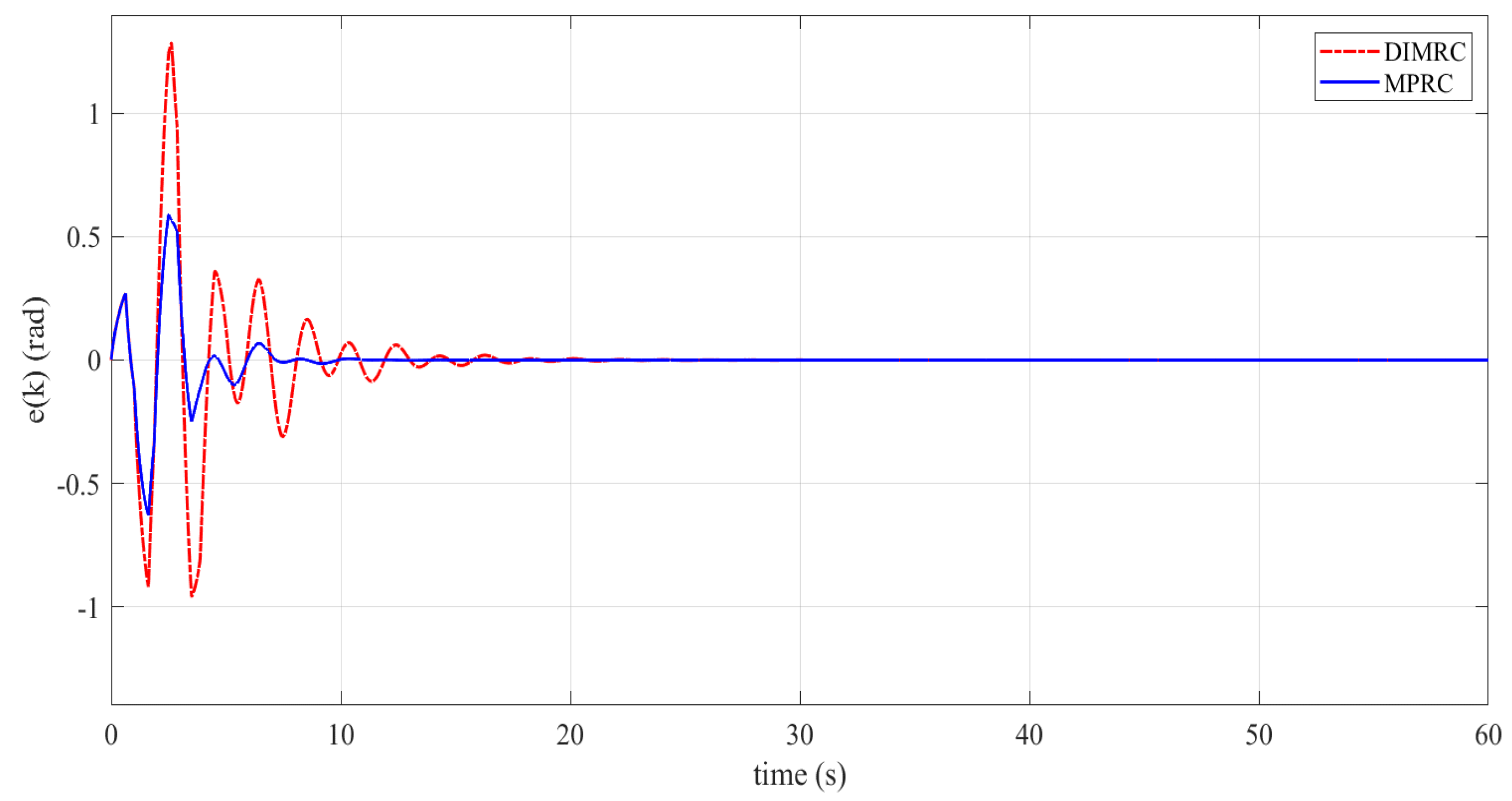
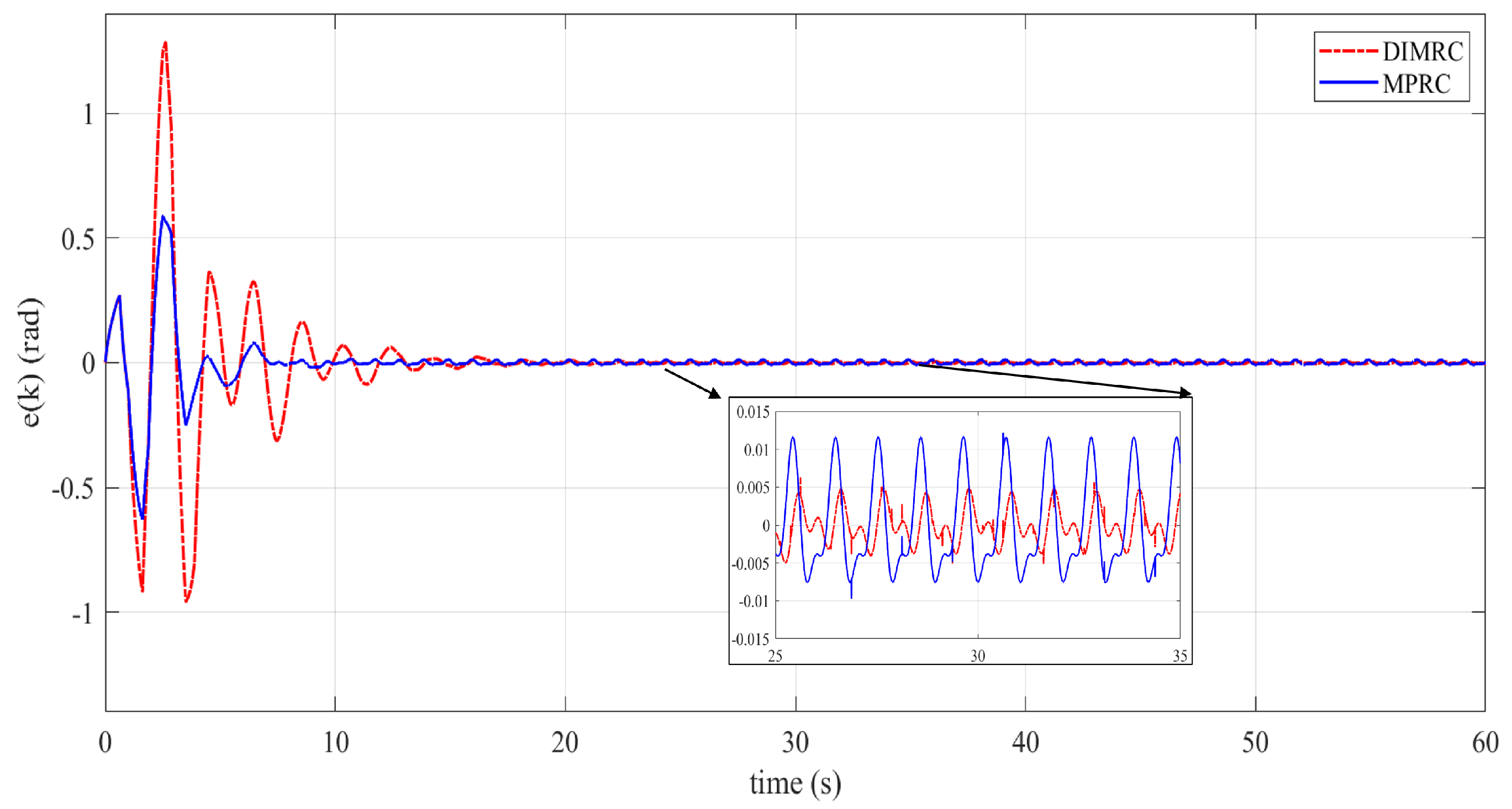
| Minimum Phase System | Non-Minimum Phase System | |||||||
|---|---|---|---|---|---|---|---|---|
| Method | ||||||||
| rms- | rms- | rms- | rms- | |||||
| DIMRC | 5.38 | 0.0022 | 5.39 | 0.0026 | 13.93 | 0.0039 | 13.88 | 0.0046 |
| MPRC | 3.625 | 0.0008 | 4.14 | 0.0029 | 7.195 | 0.0019 | 7.135 | 0.0065 |
Publisher’s Note: MDPI stays neutral with regard to jurisdictional claims in published maps and institutional affiliations. |
© 2022 by the authors. Licensee MDPI, Basel, Switzerland. This article is an open access article distributed under the terms and conditions of the Creative Commons Attribution (CC BY) license (https://creativecommons.org/licenses/by/4.0/).
Share and Cite
Prakosa, J.A.; Purwowibowo, P.; Kurniawan, E.; Wijonarko, S.; Maftukhah, T.; Sari, F.; Pratiwi, E.B.; Rustandi, D. Discrete-Time Design of Dual Internal Model-Based Repetitive Control Systems. Appl. Sci. 2022, 12, 11746. https://doi.org/10.3390/app122211746
Prakosa JA, Purwowibowo P, Kurniawan E, Wijonarko S, Maftukhah T, Sari F, Pratiwi EB, Rustandi D. Discrete-Time Design of Dual Internal Model-Based Repetitive Control Systems. Applied Sciences. 2022; 12(22):11746. https://doi.org/10.3390/app122211746
Chicago/Turabian StylePrakosa, Jalu A., Purwowibowo Purwowibowo, Edi Kurniawan, Sensus Wijonarko, Tatik Maftukhah, Farakka Sari, Enggar B. Pratiwi, and Dadang Rustandi. 2022. "Discrete-Time Design of Dual Internal Model-Based Repetitive Control Systems" Applied Sciences 12, no. 22: 11746. https://doi.org/10.3390/app122211746
APA StylePrakosa, J. A., Purwowibowo, P., Kurniawan, E., Wijonarko, S., Maftukhah, T., Sari, F., Pratiwi, E. B., & Rustandi, D. (2022). Discrete-Time Design of Dual Internal Model-Based Repetitive Control Systems. Applied Sciences, 12(22), 11746. https://doi.org/10.3390/app122211746










